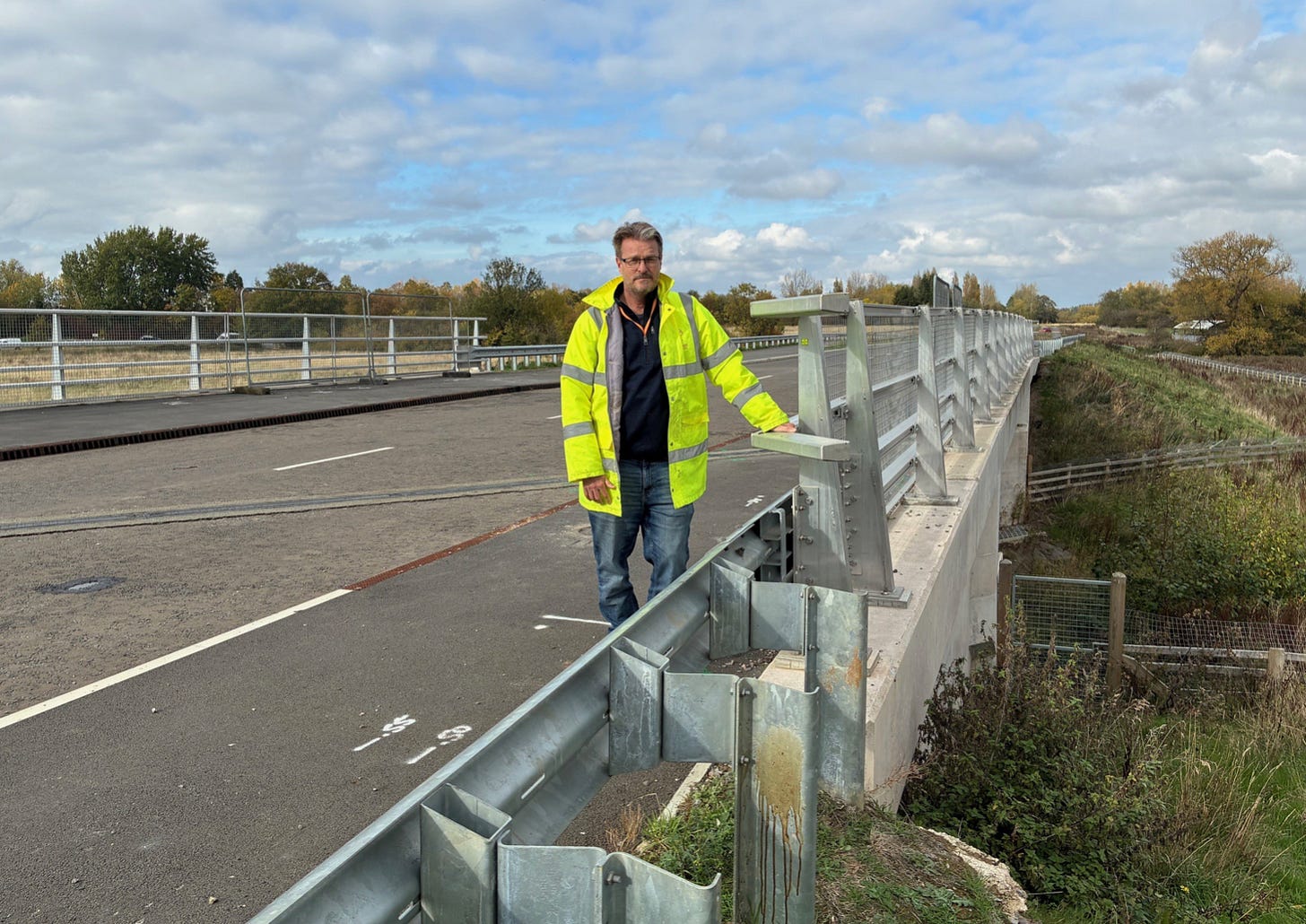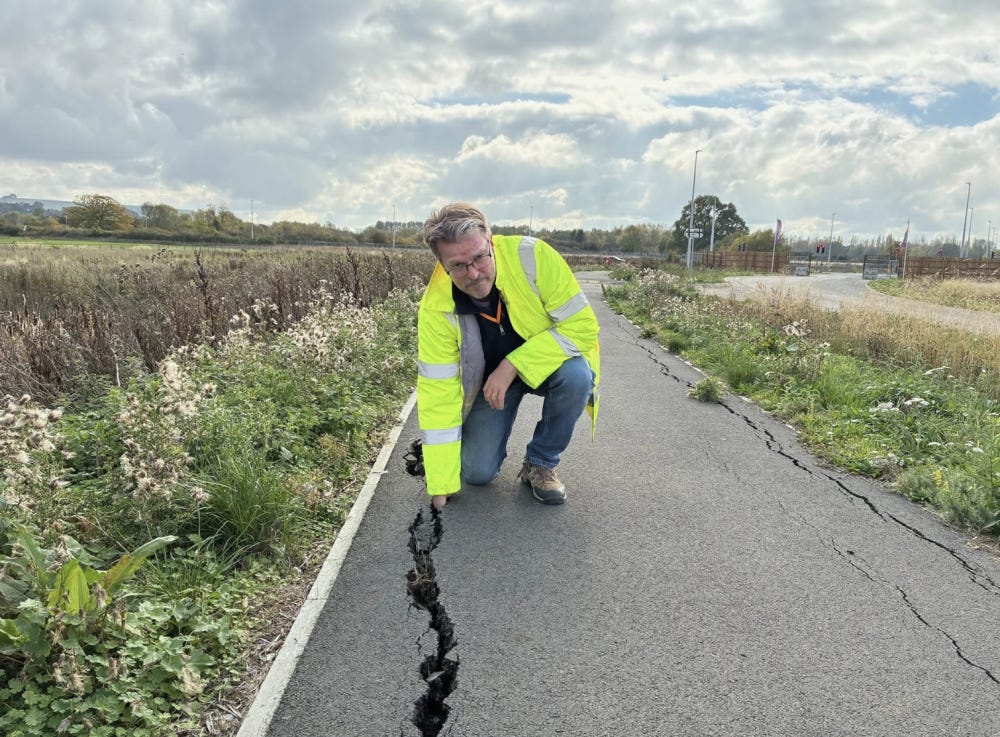Potholes, the bus boulevard and chaotic parking - the man in charge of Swindon's roads tells all
An interview with Cllr Chris Watts, Cabinet Member for the Environment and Transport, about Swindon's road network
Local issues deserve local journalists holding the powers that be to account. With local news in decline, knowing what is going on in our communities is more essential than ever. We can only exist because some of our readers are willing to support our work. If you value what we do, please consider becoming a paid supporter to ensure we can keep doing it.
You’re reading a special free edition of The Ink - curated community news straight to your inbox in association with Swindon Link. By subscribing, you are supporting the most exciting and ambitious media venture in the South West enabling us to keep you informed and up to date with everything Swindon. A subscription gives us the ability to send news analysis, updates and features direct to your inbox.
If you upgrade to be a paid subscriber you will get news sent directly to your inbox four days a week.
Upgrade now and get your first month free. The ultimate try before you buy.
It only costs £5.99 a month - less than parking in Swindon town centre for an hour once a week - and you’ll be supporting independent quality journalism in Swindon.
“The condition of local roads, the volume of repair requests, and the ambition to improve infrastructure and safety across the Borough all point to a growing demand for investment in the highways network”
Cllr Chris Watts is the man at Swindon Borough Council who is responsible for the town’s road network as the Cabinet Member for the Environment and Transport. Jamie Hill caught up with him for a Q&A about Fleming Way, potholes, parking problems and new developments.
By Jamie Hill
How has Fleming Way improved the public transport situation in Swindon?
Fleming Way has made local bus services more attractive for the public. It is a significant development compared to the former bus station and has been well received by users and residents. The quality bus shelters, real time information and passenger information have combined to make Swindon at the front of bus station design. For the first time, scheduled bus services are all operating from one location instead of Stagecoach being mainly using the old bus station and Swindon’s Bus Company using the former Fleming Way layout. The co-ordination of making this happen between the council, local bus operators and National Express has been a great success. The combined bus timetable is a great example of local bus co-ordination and the work of the Enhanced Bus Partnership.
The environment is much more pleasant for people coming into Swindon. The plants are already growing and the trees have a degree of maturity so the ambience of the area is already established. Seating is good and the shelters have phone charging pads which make it attractive for the modern generation on the go with their phones.
Overall Fleming Way is a beautiful blend of modernity and environmentally-friendly spacious location for passengers that cannot be replicated by a traditional bus station that we were all used to. A leap into the future for Swindon.
We have had a number of complaints about Fleming Way’s bus interchange but do realise there are always going to be teething problems with anything of this scale. Feedback we’ve had includes the drop-off point causing bus tailbacks all the way to Princes Street meaning that the design could have been better, and it’s also meant that people with mobility issues have to walk quite a way from the drop-off point to get their connecting buses. We’ve also had complaints about litter, toilet doors not locking despite payments and complaints that coach companies are unable to use the interchange.
We would also like to ask about the most prominent positive and negative feedback you have received and your responses to them?
This was a huge project and there were always likely to be a period of adjustment as people familiarise themselves with the road layout and the new facilities. Overall, Fleming Way has been well received by passengers using the bus and coach services. The bus stop in Princes Street was made available for coach use only and was chosen due to its proximity to three car parks. We know some passengers using Barnes coaches have raised concerns about the alternative bus stop provision, but our officers will continue to review the operation of the new bus interchange and liaise with private coach operators to understand their requirements and potential use of the area in the future. FlixBus has been provided with a bus stop at Regent Circus.
The drop-off point at Fleming Way is being addressed with bus operators so should not remain an issue. Complaints about litter and toilets are being dealt with too, but it should be noted that there are 20 litter bins for people to use.
Potholes are a perennial problem on Swindon’s roads along with overgrown vegetation on certain pavements and in some cases traffic islands. There are also numerous complaints about fly-tipping beside Swindon’s road networks. We realise that not all of them are within your authority but what are you doing about these issues that do fall under your purview?
Potholes:
We are aware that potholes remain a recurring problem, particularly during the winter months when colder weather accelerates the deterioration of road surfaces. The council operates a programme of regular inspections and prioritised repairs, with urgent potholes being addressed as soon as possible. We encourage residents to report potholes directly via the council’s website or the ‘Fix My Street’ tool, which helps us respond more efficiently. This year, with the extra funding received from the Government, we have been able to shift resources to patching work as an alternative to pothole filling and we are seeing better results with investment in new equipment and technologies. With an estimated £50m highways backlog to address, we know we are on the start of the journey to recovery.
Overgrown Vegetation:
Tackling vegetation on pavements and traffic islands is part of our scheduled grounds maintenance programme. The council had neglected this area in previous years, but we are in the process of rebuilding capacity with the help of parish councils. We are reviewing some routes where visibility and pedestrian access are particularly affected. Again, specific locations reported by residents help us target problem areas faster.
Fly-Tipping:
Fly-tipping is both illegal and unacceptable, and we take it seriously. We work with enforcement teams to investigate and remove reported waste as quickly as possible. Surveillance is used in some hotspots, and fines or legal action are pursued where evidence permits. Residents can report fly-tipping through the council’s reporting portal, and we encourage vigilance to help tackle this issue collectively. While some matters (such as issues on private land or certain National Highways routes) may fall outside our direct control, we do liaise with the appropriate bodies to raise concerns and request action where needed. We are also currently recruiting a further three offices to help support the team.
The opening of Devizes Road has happened after months of closure. What lessons have the council learnt from this closure of a major thoroughfare? There are now calls for changes to be made to the area with different ideas being put forward from making Devizes Road a 20mph zone, making it access only for HGVs, closing the road at weekends or for events, making it one-way, or even on the extreme end making Devizes Road and Wood Street pedestrian zones. What are your thoughts on this?
Firstly, we fully recognise the disruption caused by the extended closure of this major thoroughfare. This was important health and safety work by Wales and West to remove a cast iron main gas pipe that was installed in the 1950s. While the work undertaken was essential, we understand that it had a significant impact on residents, businesses, and traffic flow in the surrounding areas. We understood the importance of early and ongoing communication - not just about the reasons for the closure, but also about expected timelines, diversion routes, and support for local businesses, which why we supported their applications for pavement licences. In terms of coordination, the council took full advantage of the road closure as works neared completion to programme in some outstanding resurfacing works and this was completed on 10 October 2025.
As for the future of Devizes Road, we’re aware of the growing interest in reimagining the area, both to support local businesses and to enhance the experience for pedestrians, cyclists, and residents. Any significant change would require careful planning, public consultation, traffic impact assessments, and engagement with businesses and residents to ensure the outcomes are practical, balanced, and widely supported.
There is real value in exploring creative ways to make areas like Devizes Road more people-friendly, especially where it supports local trade, improves safety, and promotes active travel. That said, we must also consider access for deliveries, emergency services, and how changes might affect neighbouring streets.
How big is the Highway team at SBC? How much does it consume annually of the council budget? Does it need more resources?
Team Size:
The Highways Team at the council is made up of a combination of in-house staff and contracted services, including engineers, planners, inspectors, maintenance crews, and support officers. While the exact number of staff can vary depending on projects and seasonal needs, the core Highways Team typically includes around 60 council officers, supported by external contractors for larger maintenance and infrastructure projects.
Annual Budget:
The highways service budget is drawn from a mix of local funding and external grants, including allocations from central government for specific schemes (e.g., pothole repair funds or capital investment in infrastructure). On average, the annual budget for highways (including maintenance, street lighting, traffic management, and improvement schemes) is approximately £5.5m, though this can vary year by year based on funding settlements and project demands. Due to years of reduced funding from central government, resulting in an estimated £50m highways maintenance backlog in Swindon, managing this budget is crucial to ensure we get the best value for money.
Does the Team Need More Resources?
Like many local authorities, the council faces the ongoing challenge of delivering core services with constrained resources. The condition of local roads, the volume of repair requests, and the ambition to improve infrastructure and safety across the borough all point to a growing demand for investment in the highways network. There is a case to be made for increased funding and staffing, particularly to allow for more proactive maintenance rather than reactive repairs. However, this needs to be balanced within the wider context of the council’s overall considerable budget pressures and statutory responsibilities. We continue to seek opportunities to secure additional external funding (for example, from the Department for Transport or developer contributions via Section 106 and Community Infrastructure Levy agreements) and to prioritise work based on need, safety, and long-term value for money.
What major plans are there to improve Swindon’s road system in the short term and the long term?
In the short term, we plan to continue to resurface priority roads, addressing potholes, and continuing to improve road safety by introducing interventions, especially around schools.
In the long term, major projects include infrastructure to support the New Eastern Villages development, continued investment in cycling and walking routes through the Local Cycling and Walking Infrastructure Plan, strategies to support electric vehicle adoption and reduce congestion. The council is also exploring ways to make the road network more resilient, sustainable and better integrated with public transport as Swindon grows.
Swindon is an ever-growing town. How do you ensure the necessary road infrastructure is part of any new developments?
Highway infrastructure is planned both strategically, through the Local Plan, and more specifically through the planning application process.
The Local Plan spatial development strategy is supported by an Infrastructure Delivery Plan which evolves as site allocations are firmed up. This assesses infrastructure required to support new development including highway improvements. These are then costed and listed alongside other infrastructure which is then viability tested and prioritised for delivery.
Once a planning application is submitted it will likely require a Transport Assessment which is independently evaluated by, or on behalf of the council. This assessment will determine the extent and nature of required highway which will be delivered both on site and off site through costed and justifiable contributions.
Residents’ parking is a huge problem across Swindon. There are too many estates that have been built without sufficient car parking spaces for the number of households. How are you resolving these issues and ensuring that any future developments (including HMOs) don’t cause more problems?
In terms of parking, development is determined against local parking standards. These standards were derived from a local application of national standards. It is likely that these local parking standards will be reviewed in the future to support the emerging Local Plan to 2043. Refusing development in contravention of adopted local parking standards would likely result in planning appeals, which the council would be very unlikely to win and be liable for considerable costs.
Are Swindon’s roads Winter-ready?
Our Operations team are now on standby to begin gritting whenever temperatures drop.
We’re putting everything in place before winter really sets in, so we can act fast when freezing conditions hit. To get ready, we’ve stocked up with around 2,000 tonnes of salt, ready to spread across 210 miles of priority routes when icy weather arrives.
Town centre parking is also a massive issue with businesses claiming that the charges are a major blockage to their work when people can park for a lot less at the outlet village or for free at places like West Swindon District Centre, The Orbital and Greenbridge. How are you addressing this issue?
We are currently reviewing all fees and charges relating to parking in Swindon to make the experience suitable for anyone who wants to work, visit and stay in Swindon. We have consulted with businesses to understand their position as part of setting rates for next year.
On the subject of parking, are there any plans to reintroduce ‘park and rides’? One idea that we’ve put forward in the past is for a park and ride at one of the motorway junctions with a circular hop-on, hop-off service taking people to The Outlet Village, North Star and the station, The Town Centre and Old Town. Are there any big ideas like that in the offing?
A park and ride as part of the New Eastern Villages development is still part of the overall plan for that area. There are no other plans for park and rides at this current time.
Can we have trams back please?
Trams, while a nice and nostalgic idea, would be too expensive to bring back in the current climate. We’ve also just opened the revamped Fleming Way so would encourage people to make use of buses to move around Swindon.
The Ink News Briefing
Platform Project welcomes Swindon MP - South Swindon MP Heidi Alexander paid a call on The Platform Project – a not-for-profit supporting young people struggling in mainstream education. The Platform Project works closely with schools, local authorities and employers to help disadvantaged and vulnerable young people build the skills, experience and confidence they need to succeed in the workplace. Full Story here
Swindon bakery wins ‘Best Doughnut’ accolade at PETA’s 2025 Vegan Food Awards - Artisan bakery Pipp & Co has scooped the Best Doughnut category in PETA’s 2025 Vegan Food Awards just a few months after launching its vegan range. Full Story here
Would-be kidnapper grabbed teenaged girl in Swindon street - A man has pleaded guilty to attempting to kidnap a 17-year-old girl in Swindon. Abdulmawal Ibrahim Adam, 27, of Stanier Street, Swindon, admitted the offence in a hearing at Swindon Crown Court. He has been remanded into custody and is due to be sentenced on 12 December. Full Story here
The Ink takes a journey through a portal to hell
A rather strange and curious email suddenly appeared in the Ink’s inbox last week, dear reader. One minute it wasn’t there, the next, it was. Very odd.
By Amanda Wilkins
We opened the strange and curious missive with slight hesitation and as it blinked to life on our screens, the room took on a distinct, arctic chill. It was an invitation, dear reader, to a séance at Roves Farm. Being the brave and stalwart journalists that we are, we accepted the invite, said farewell to our loved ones, and prepared to experience the fright of our lives.
On a dark and sinister night, when the veil between this world and the next was stretched as thin as the shadow of a hair, we climbed aboard a tractor at Roves Farm and set off on in search of the séance.
Travelling for what felt like an eternity, across dark and treacherous terrain, we finally came upon a clearing in the hedge. After being ordered off the vehicle and into the eerie and foreboding woods, we stumbled upon an altar, piled high with skulls and bones. We were ordered to form a circle and hold hands as we chanted dangerous, forbidden words.
Thunder rolled, lightning flashed and a hideous, menacing demon suddenly appeared within our midst. The terrifying figure proceeded to open a portal to hell, awakening the malevolent spirits who were only too eager to escape their hellish confines and disappear into the moonlit night.
After being ordered back onto the tractor we found ourselves flying through the fields of farm on a journey far too terrifying to fully explain here, dear reader. I can tell you that it involved clowns, undead children, hillbilly hicks and chainsaws but that is all. I’m afraid my mind has blanked out nearly all the nights dreadful details.
The Editor vaguely remembers a hay maze and being scared half to death by a member of the undead, but his recollection is also a little scattered.
We found ourselves, hours later, back in Old Town, rather shaken, clutching half eaten cupcakes and Roves Farm merchandise. We did attempt to take photographs which I’ve included in this piece, although the quality is somewhat lacking; the dead were reluctant to allow their images to be captured on film.
If you find yourself in need of a proper scare, dear reader, I highly recommend you take part in ‘Portal to Hell’, the live action scare attraction brought to you by Totally Crazy Entertainment and Roves Farm.
This awesome, live action experience runs for the evenings of the 24 to the 26 of October at Roves Farm.
This year there are two awesome scares; Portal To Hell is a dark ride around the lanes and fields where anything can and will happen, and The Haunted Hay Maze where it’s up to you to try and survive.
It is not for the faint of heart or sensitive of spirit, however. As the Halloween attraction contains live actors, scares, gore, intense situations, flashing lights and loud noises (mostly you screaming) it’s been given a suggested minimum age suitability of 12 years old, so book with caution!
For further information and to book tickets, visit: totallycrazy.co.uk/halloween
The Swindon Link Magazine Archive
Over on The Ink’s sister publication Swindon Link’s website you will find an impressive archive of the past 47 years of Swindon Link magazines, giving you a huge glimpse into the town’s recent past from the beginnings of West Swindon to now. You can find the archive here.
The latest magazines
For the North West Swindon Link Magazine click here
For the South East Swindon Link Magazine click here
To contact The Ink directly email - theink@positive-media.co.uk







